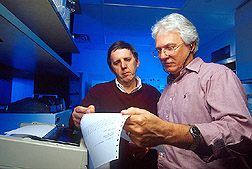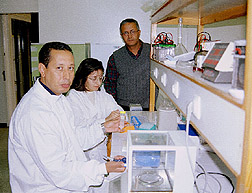Tracing Tickborne Diseases at Home and Abroad |
|
|
|
Livestock owners in the United States and Morocco will benefit from a collaboration between ARS and the north-African nation. Twenty-eight million sheep, goats, cattle, donkeys, and horses provide food, fiber, and transportation in Morocco. Tickborne diseases—babesiosis, theileriosis, and anaplasmosis—cause illness and death in the animals, economic loss to their owners, and trade restrictions for the country. But until now, livestock owners have had no way to differentiate among these three diseases. "Disease-specific tests routinely used in the United States as well as new tests for anaplasmosis and babesiosis developed at our laboratory can help the Moroccans determine the prevalence and impact of each disease," says ARS microbiologist Willard L. Goff. |
|
|
"American livestock owners benefit, too," says ARS veterinary medical officer Donald P. Knowles. That's because each new diagnostic test must be performed under a variety of conditions before it can become an international standard. These standards are used to protect American animals from foreign diseases. (See "New Test to Keep Horses Healthy," Agricultural Research, July 2000, p. 8.) Goff and Knowles work at the ARS Animal Disease Research Unit in Pullman, Washington. Funded through USDA's Foreign Agricultural Service, researchers from ARS and USDA's Animal and Plant Health Inspection Service (APHIS) spent 5 years collaborating with Moroccan scientists to characterize that country's disease problem. Moroccan colleagues, led by parasitologist Hamid Sahibi and immunologist Abdelkebir Rhalem, came to Pullman to learn how to use the tests. Then the team set up the necessary equipment and protocols at the Institut Agronomique et Veterinaire in Rabat, Morocco. Blood samples—and 5,000 ticks—were then collected from cattle, horses, and donkeys at 26 sites throughout the roughly California-sized country. The tests confirmed the presence of each disease-causing organism, including the first verification in Morocco of anaplasmosis in cattle. But theileriosis proved to be the most prevalent tickborne disease in cattle, with nearly half the samples testing positive. Almost two-thirds of the donkeys and horses tested were found to have equine babesiosis, also called piroplasmosis. The next phase of the research will focus on the ticks that transmit the diseases. Three tick species were identified as likely carriers, but additional molecular work is necessary to confirm the role of each species. Jerome Freier, a geographic information systems specialist with APHIS, will also use remote sensing with satellite imagery to better define conditions favorable to ticks and how the ticks are likely to spread. "With this information, control strategies for these diseases can be designed in Morocco," says Goff. "All of this research benefits the disease surveillance program in the United States too."—By Kathryn Barry Stelljes, Agricultural Research Service Information Staff. This research is part of Animal Health (#103) and Arthropod Pests of Animals and Humans (#104), two ARS National Programs described on the World Wide Web at http://www.nps.ars.usda.gov. Willard L. Goff and Donald P. Knowles are in the USDA-ARS Animal Disease Research Unit, Washington State University, Pullman, WA 99164-6630; phone (509) 335-6029, fax (509) 335-8328. |
|
"Tracing Tickborne Diseases at Home and Abroad" was published in the April 2001 issue of Agricultural Research magazine. |
|








